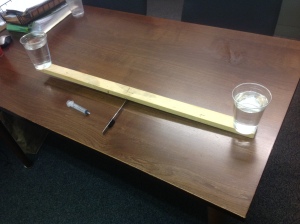Class topic – Buoyancy force
This is a neat demonstration that I learned from retired Clemson Professor Ben Sill. You build a see-saw with cups of water balanced on the ends. Then, if you push a finger into one of the cups touching only the water, the cup will drop down. You appear to be pushing down on water.
Equipment
This can be reasonably easily built using plastic cups and office supplies. A sturdy ruler can be used for the see-saw (I use a small length of wood about 1.5×4 cm and 1 m long) and plastic cups to hold the water. I use a cheap steel knife as the edge to balance the see-saw on and double sided foam tape to hold the cups to the see-saw. You will also need a jug of water and it can be useful to have a 10 ml syringe so that you can slowly add water to the cups when you are doing the final balancing.
Demonstration
Set up the see-saw with the cups empty such that it is as close to being balanced as you can get it.
- Fill each cup with water such that they are about 80% full and re-balance by slowly adding water to the higher one using the syringe.
- Ask the class if it is possible to push down on water (you can do this while setting up). Ask them to think about pushing down on a bath tub full of water. Does the water resist your pushing?
- Once it is all balanced (or close to balanced) push one or two fingers into the higher of the two cups.
- If the balance is close enough and you can push your finger far enough into the cup (without actually touching the cup) then the cup with your finger in it should drop.
If you invest time to get the see-saw perfectly balanced then you can continue the demonstration as follows:
- With the cups balanced drop a penny in one of cups and watch the cup drop.
- Push your finger into the higher cup until it starts to re-balance.
- Note how far you need to push your finger into the water to re-balance the cups.
Class discussion
Ask the class what they observed. The basic observation is that as you place your finger in the water the water level goes up. Therefore, water is displaced and there must be a buoyancy force acting on your finger. The depth increase increases the hydrostatic pressure acting on the base of the cup. That is, the reaction to the buoyancy force is transferred to the base of the cup by the water level rising. This, in turn, pushes the cup down.
Analysis
If you are able to get everything balanced enough to do steps 5-7 then you can calculate the weight of the penny. The weight of the penny will be balanced by the buoyancy force acting on your finger. Estimate the diameter of your finger (D) and the depth you pushed it into the cup (H). Approximating your finger as a cylinder, then the weight of the penny is given by Wp= ρg H π D2/4. Check the actual answer online before you do this so that you can verify the accuracy of your calculation. The following links give coin weights in the US, UK, Eurozone, Canada, and Australia.

Pingback: Pushing down on water video | Teaching Fluid Mechanics
Dear Nigel:
If this demonstration is done with a single cup on a digital balance of sufficient sensitivity, it becomes more interesting. We would notice that for very small (of the order of mm) immersion depths of the finger the weight would actually decrease, before it will increase with larger immersion depths. This is because the surface tension exerts an upward ( since the finger is wetting) force, which will dominate for small immersion depths of the finger, compared to the downward pressure at the finger tip. The downward pressure at the finger tip is proportional to the immersion depth, due to which this force will dominate at larger immersion depths.
Regards
Baburaj